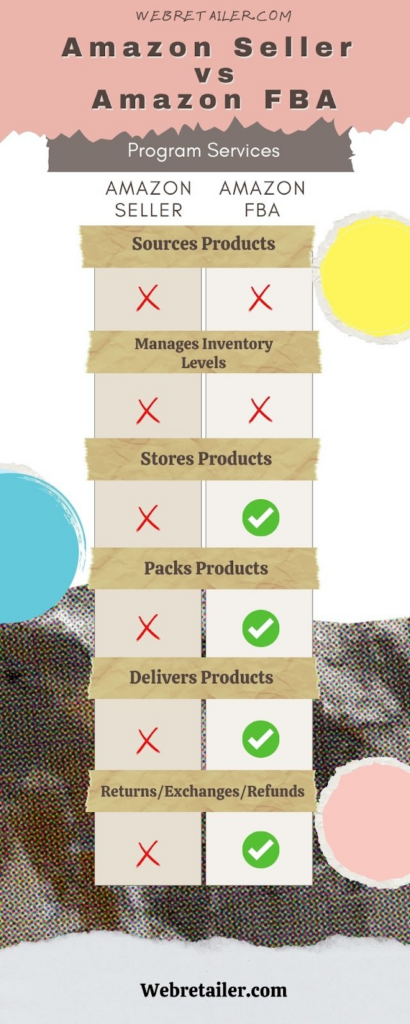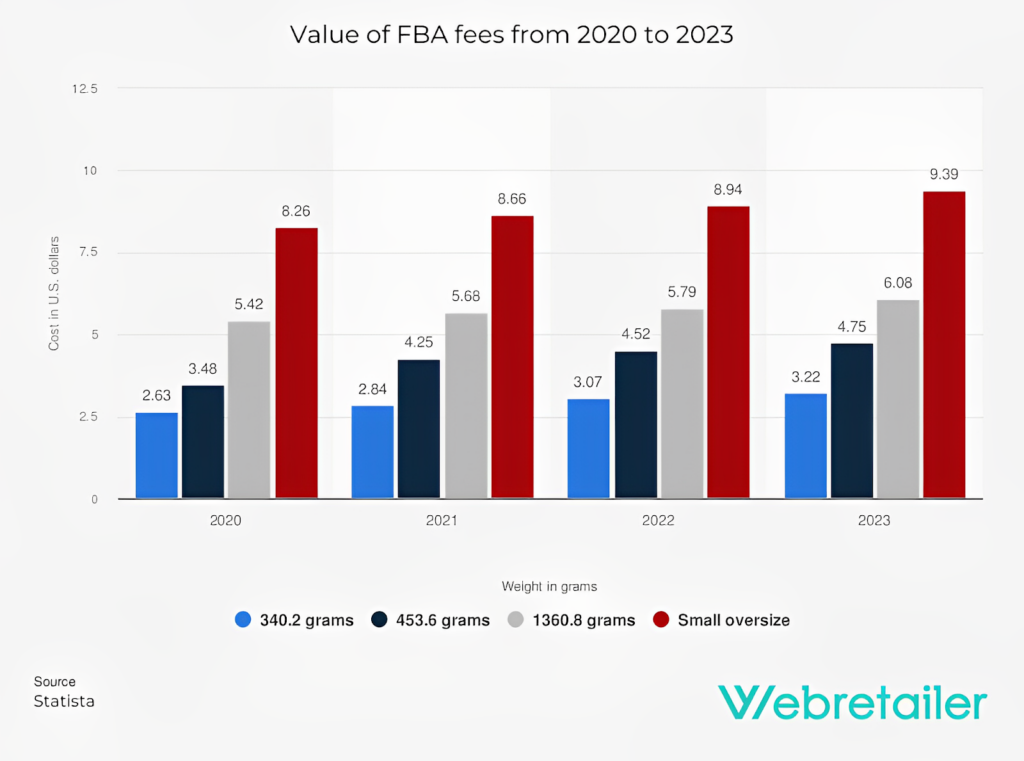Fulfillment By Amazon (FBA) is a service for Amazon third-party sellers that stores, packs and ships their products so they don’t have to do it themselves. It also handles after-care customer service like returns and exchanges. That means if you are selling a product on Amazon you have the option of doing all of that work yourself or hiring Amazon FBA to do it.
What’s the Difference Between Amazon FBA and Amazon Sellers?
With close to $22 billion in sales in 2021 alone, Amazon is a lucrative platform whether you’re an Amazon seller or an Amazon FBA seller. The difference between joining one program or the other comes down to how much of your Amazon business you want to outsource.
Amazon sellers are either first-party sellers or third-party sellers. First-party sellers sell directly to Amazon and Amazon then sells those products to customers. Amazon third-party sellers, who are responsible for almost 60% of the sales that take place on the Amazon platform, sell directly to customers. The Amazon FBA program is designed for third-party sellers.

If you are an Amazon third-party seller that means you can upload your products to sell on the Amazon platform. You’re responsible for product sourcing, listing your product on Amazon, marketing, warehousing, packing, shipping, and dealing with customer returns and refunds.
If you join Amazon FBA, you don’t have to handle the warehousing, packing and shipping of your products, or dealing directly with customers about after-sale issues.
Can All Third-party Sellers Use Amazon FBA?
Most third-party sellers on Amazon can use Amazon FBA, but not all. Amazon FBA has a short list of restricted products such as vehicle tires, loosely packed batteries, and alcohol that they will not fulfill for third-party sellers.
So, if you sell those restricted items, you won’t be able to use Amazon FBA to fulfill your orders; instead, you’ll have to handle it yourself. However, for the most part, most of the things that are sold on Amazon can be housed, packed, and shipped by Amazon FBA.
MORE: Find details about various Amazon seller tools.
How Does Amazon FBA Work?
There are several things you need to do before you can use Amazon FBA.
- Open an Amazon Sellers Account
Before you can start with Amazon FBA, you’ve got to open up a seller account with Amazon.
- Get Approved to Sell on Amazon
Once Amazon approves your application, you are registered to sell on Amazon.
- Decide Between Amazon Sellers and Amazon FBA.
You will have the option to do all of the warehousing, packing, shipping and after-care customer service yourself or you can choose Amazon FBA to do it for you. If you choose Amazon FBA to do those things for you, you become an Amazon FBA seller.
What To Do After Setting Up Your Amazon FBA
If you have just set up a new seller Amazon FBA accoun,t you’ll need to create your product listings. Then comes one of the most important parts of the whole Amazon FBA process – inventory packaging and labeling. Amazon has strict rules about how they want to receive your products, and if you don’t follow them, your Amazon FBA sales journey will take months to get off the ground.
Get Your Packaging and Labels Right
Amazon FBA has very precise rules on how they want your products packaged, labeled, and shipped. With millions of products shipping north, south, east, and west every single day, you’ve got to appreciate why they need to be extremely precise about their inventory and warehousing rules.
You will receive instructions on how to package and label your products correctly before sending them to Amazon. If you’re dropshipping them, then provide these instructions to your drop shipper to make the process go as smoothly as possible. If you are shipping the products yourself then follow the instructions and ship them to the Amazon warehouse location you’ve been allocated.
Once Amazon receives your shipment and accepts it, you can focus on marketing, maintaining inventory levels, and growing your business.
How Much Does Amazon FBA Cost?
There is no one fixed cost to utilizing the Amazon FBA program for your business. Amazon fulfillment fees depend on a variety of factors. The two main parts of Amazon FBA costs are the storage fees and the packing/shipping fees.
How Are FBA Storage Fees Determined?
Storage fees depend on the month of your storage and the amount of space your product is taking up in the Amazon warehouse. The busier the time of year, the more valuable the space in the Amazon warehouse and the higher the fee for your storage.
Estimated Costs for Storage Fees
| Product | January – September | October – December |
|---|---|---|
| Tablet – Small standard 10.6” x 8.1” x 0.7”0.03 cubic foot | $0.15/ per month | $0.54/ per month |
T-shirt – Large standard 8.5” x 4.8” x 1”0.02 cubic foot | $0.08/ per month | $0.24/ per month |
| Iron – Large standard 12.6” x 6.6” x 5.5”0.3 cubic foot | $1.24/ per month | $3.60/ per month |
| Monitor – Large oversize 54” x 35” x 3.5”3.8 cubic foot | $10.07/ per month | $22.80/ per month |
Source: Amazon FBA
What Are Pack and Ship Fees?
There are three main factors on how much you will be charged per item for Amazon to pack and ship for you. You can use the Amazon FBA calculator to figure out what your costs are once you’ve signed up. However, below are the main factors in how they are going to calculate your fees.
Product Type
Different types of products are associated with different fees. For example, apparel and electronics have different fee structures. Additionally, hazardous goods have a different structure than non-hazardous goods.
Amazon Package Size
Amazon FBA has different fees for different-sized products much like courier services do. A small-sized product is going to cost less to ship than a large-sized product and the fee you are charged is based on that.
Additionally, they’ve got different charges for different tiers of oversized products. You can have a small oversized product versus a large oversized product and your fee will be based on their evaluation of where your product fits in that tier.
Product Weight
The weight of your product is a tricky one because Amazon FBA determines your fee based on the actual weight of your product or the dimensional weight. The dimensional weight of your product includes the size as well as the weight.
Let’s say you have a very large product that is quite light, your fee is going to come from both of those factors, not just the weight alone.
On the other hand, you might have a very small-sized product, but it’s very heavy. Once again your fee will be calculated using both of those metrics rather than just the shipping size alone. Essentially, Amazon FBA will calculate the actual weight of the product as well as the dimensional weight and charge you based on whichever weight is greater.
Check the graph below for value of FBA fees statistics:

From 2020, the value of FBA fees rose in accordance to the weight of the package. Third party sellers now have to pay more when selling on Amazon. In 2023, for products weighing up to 340.2 grams, the fee rose from 2.63 USD to 3.22 USD. For products weighing between 340.2 grams to 453.6 grams, the fee rose from 3.48 USD to 4.75 USD.
As for products weighing between 453.6 grams and 1360.8 grams, the price rose from 5.42 USD to 6.08 USD. For other small oversize products, the price rose by 1.13 USD. Further increase of price for Amazon sellers can be expected in the upcoming years.
What Are the Benefits of Using Amazon FBA?
The biggest benefit of using Amazon FBA is that you can offload a large part of your business logistics to Amazon. Packaging, shipping, and dealing with returns and refunds take a massive amount of time. If you decide to use Amazon FBA, you don’t need to spend too much time on that portion of your business.
- Warehousing
You don’t have to worry about finding a place to store your goods because Amazon FBA stores them for you
- Packing
When a customer purchases your product, Amazon finds it in their warehouse and packages it for you.
- Shipping
Amazon FBA assembles your packed parcel, generates the shipping labels, and ships the product for you.
- Customer Service
If your customer is dissatisfied with the product, Amazon FBA handles it. They process exchanges and refunds on your behalf.
What Are the Cons of Using Amazon FBA?
First off and foremost, you are outsourcing a large part of your business to a third party, which means a loss of control over the process. That loss of control means there are many things that you no longer can change and shift as you manage your sales.
You can use tools to manage your Amazon FBA to make the process flow easily, but be aware of the things that are hard to control.
- No Individualized Packaging
If you’re packing your items yourself, you can make changes to your packaging, include personal notes, and just overall make it a unique experience.
- You Can’t Determine Shipping
While Amazon is speedy, you have no control over when your customer is going to get their product.
- Customer Returns Are Not Up to You
When a customer returns a product, Amazon FBA makes the decision on refunds and exchanges instead of you.
- Increasing Costs
Amazon FBA sellers have seen increasing fulfillment costs from 2020 to 2023. For example, a small package weighing 340.2 grams cost $2.63 in 2020 and went up to $3.22 in 2023.
Is Amazon FBA Worth it?
Amazon FBA can be a great tool to help you grow your business but all tools come with benefits and costs. Is Amazon FBA worth it? That all depends on what stage you are at with your business. The greatest benefit of this tool is that you can outsource warehousing, packing, and shipping. The benefits of Amazon FBA can outweigh the costs for medium-to-large businesses but for small local businesses, they can be prohibitive.
Key Takeaways
Fulfillment by Amazon is a useful tool, but how useful it is depends on where you are in your business journey. Outsourcing a large portion of your business can be a great help in costs, however you do lose some control.
If you are at a stage in which you want to focus on personalizing your packaging and connecting directly with customers then Amazon FBA might not be for you. On the other hand, if you’d rather focus on sourcing and selling products and versus fulfillment than Amazon FBA could be a great fit.

Leave a Reply